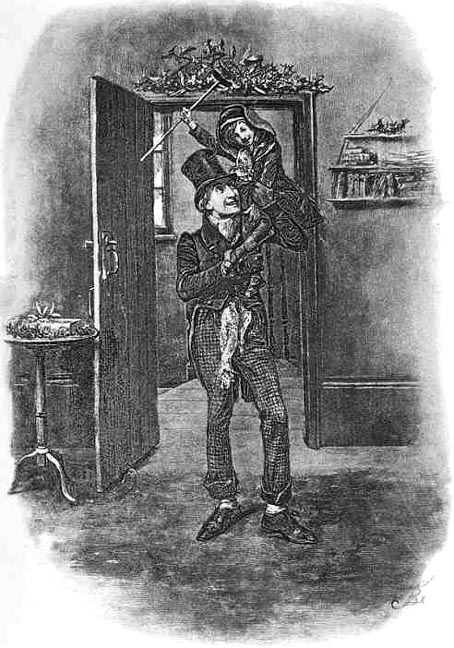Tiny Tim with his crutch
Harold Copping
1924
Lithographic reproduction of line drawing
5 by 3 ⅜ inches (12.9 x 8.8 cm)
From Children's Stories from Dickens, p. 49.
[Click on image to enlarge it.]
Scanned image and text by Philip V. Allingham.
[Victorian Web Home —> Visual Arts —> Illustration —> Harold Copping —> Next]
Tiny Tim with his crutch
Harold Copping
1924
Lithographic reproduction of line drawing
5 by 3 ⅜ inches (12.9 x 8.8 cm)
From Children's Stories from Dickens, p. 49.
[Click on image to enlarge it.]
Scanned image and text by Philip V. Allingham.
[You may use this image without prior permission for any scholarly or educational purpose as long as you (1) credit the person who scanned the image, and (2) link your document to this URL in a web document or cite the Victorian Web in a print one.]
"And how did Tim behave?" asked Mrs. Cratchit.
"As good as gold and better," replied his father. "I think, wife, the child gets thoughtful, sitting at home so much. He told me, coming home, that he hoped the people in church, who saw he was a cripple, would be pleased to remember on Christmas day who it was who made the lame to walk."
"Bless his sweet heart!" said the mother in a trembling voice, and the father's voice trembled too, as he remarked, that "tiny Tim was growing strong and hearty at last." ["Tim Tim," in Children's Stories from Dickens, 53]
The picture subtly suggests that such is not the case. The beautiful child is clearly too small for the child's crutch that his financially-strapped parents have bought for him, perhaps second-hand. The illustration exaggerates the size of the crutch, perhaps in order to suggest that the long-haired, beautifully dressed Victorian child is somewhat small for his age. The illustrator has isolated the figure, giving Tiny Tim no context, whether it be the Cratchit parlour or the church, to compel the reader to study him as isolated, cut off from children's games and activities outside the home. He is in Copping's headpiece pathetically sweet, although perhaps too well-dressed for the youngest child of four in a financially struggling urban family during the Hungry Forties.



Left: Fred Barnard's cheerful composite woodblock engraving for the British Household Edition, He had been Tim's blood-horse all the way from church, and had come home rampant (1878). Centre: Eytinge's interpretation of the scene in which the family welcomes Bob home, Bob Cratchit at Home. Right: Charles Green's interpretation, Bob Cratchit and Tiny Tim,: For he had been Tim's blood-horse all the way from church, and had come home rampant (1912) shows an older, somewhat careworn father.


Left: Barnard's photogravure version of Bob and Tim's return from church, Bob Cratchit and Tiny Tim. Right: Sol Eytinge, Jr.'s headpiece for Stave Three: woodblock engraving Tiny Tim's Ride (1869).


Left: Charles Brock's 1905 engraving of the Cratchit family's enthusiastically welcoming the arrival of the dessert course, "Oh, a wonderful pudding!". Right: Charles Green's rather less exuberant realisation of the Camden Town festivities suggestive of the Dickenses' own in Charles's youth: Christmas Day at Bob Cratchit's (1912).
Dickens, Charles. A Christmas Carol in Prose, Being A Ghost Story for Christmas. Illustrated by John Leech. London: Chapman & Hall, 1843.
Dickens, Charles. A Christmas Carol in Prose: being a ghost story for Christmas. Illustrated by Sol Eytinge, Junior. Boston: Ticknor & Fields, 1869.
Dickens, Charles. A Christmas Carol. Illustrated by Harold Copping. London, Paris, New, York: Raphael Tuck, 1911.
Dickens, Charles. A Christmas Carol. Illustrated by Charles Green, R. I. London: A & F Pears, 1912.
Dickens, Mary Angela, Percy Fitzgerald, Captain Edric Vredenburg, and Others. Illustrated by Harold Copping with eleven coloured lithographs. Children's Stories from Dickens. London: Raphael Tuck, 1893.
Dickens, Mary Angela [Charles Dickens' grand-daughter]. Dickens' Dream Children. London, Paris, New York: Raphael Tuck & Sons, Ltd., 1924.
Matz, B. W., and Kate Perugini; illustrated by Harold Copping. Character Sketches from Dickens. London: Raphael Tuck, 1924. Copy in the Paterson Library, Lakehead University, Thunder Bay, Ontario, Canada.
5 October 2023
